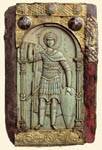|
|
| Byzantine Minor Arts |
11th c. Vatopedi Monastery Steatite and silver, carved and embossed 15 x 9 cm; 21 x 13.5 cm (with frame) Constantinople |
|

|
This icon of St George, carved in pale green steatite, has a wooden frame ornamented with a silver revetment, which is probably of later date. The saint is pictured full-length and frontal in the characteristic attitude of the warrior saints: left hand holding his shield, the point of which is resting on the ground, and right hand raised, grasping the lance in repose beside him. His military garb, with its heavy folds, is rendered in exquisite detail. The facial features are carved with delicacy and precision, and are in some ways similar to those in the portrait of St Theodore on two eleventh-century steatite icons (Kalavrezou-Maxeiner 1985, nos. 6-7, pp. 99-101). These works, in fact, share a number of iconographic elements, including the shape of the shield and the positioning of the figures under a palmetted arch reposing on a pair of columns with the familiar Herakles knot: indeed, the columns and the arch are of a type found on many eleventh- and twelfth-century ivories and steatites. The triumphant attitude of the martial figure is thought to be intended to present St George as a victorious warrior and defender of the Christian faith, as well as of the icon's owner, who frequently bore the name of the saint depicted. Tradition has it that the icon was donated to the Monastery by a relative of the Emperor John VI Cantacuzenos (1347-54), from Ioannina (Theophilos 1972, p. 103). The silver revetment of this icon preserved on the upper parts of both the frame and the icon itself, with its prominent bosses displaying the monogram of the saint's name, its intricate ornamental motif of a fluted latticework ribbon with three knops, and the undulating tendril scroll in low relief, all typically fourteenth-century work, tend to confirm this tradition. It should be noted, however, that the repairs made to the worn silver revetment have employed sheets of metal from two different periods, not necessarily connected with the actual date of the intervention. These are the strip on the bottom of the frame, with linked figures-of-eight framing flora motifs, an ornament reminiscent of a staurotheke ascribed to the twelfth or thirteenth century (Byzance 1992, p. 336, no. 249), and the small strip on the upper right-hand part of the frame, with a representation of St John the Theologian, according to the inscription, which is probably post-fourteenth-century. These two strips must have been taken from the revetment of similar icons or caskets.
| |
|
Bibliography: Kalavrezou-Maxeiner 1985, pp. 101-2, no. 6 (with earlier bibliography). Loverdou-Tsigarida 1996, p. 460, fig. 392.
| ||
| K. L-T. | ||
| Index of exhibits of Monastery of Vatopedi 11th century |
||
Reference address : https://www.elpenor.org/athos/en/e218ci1.asp